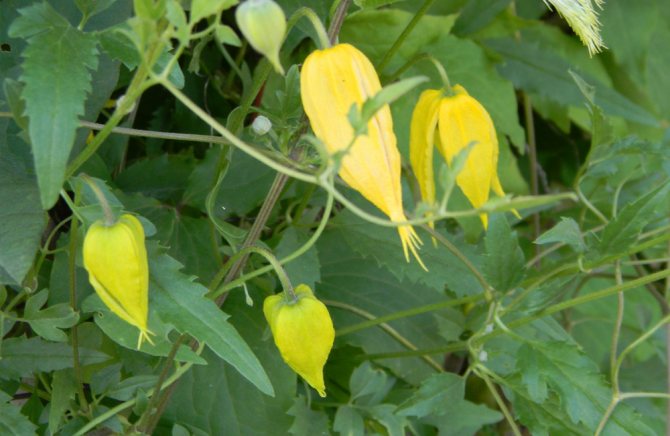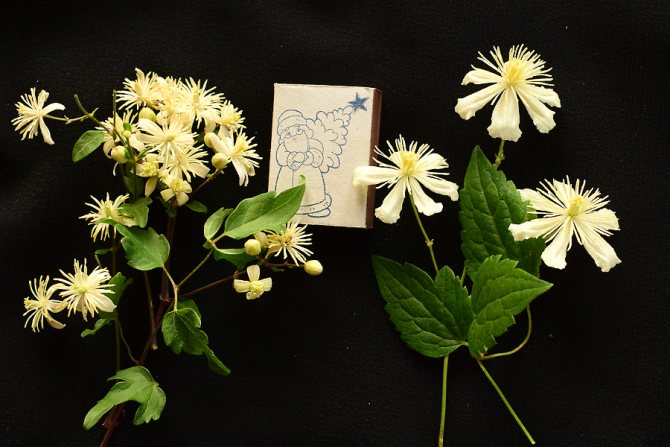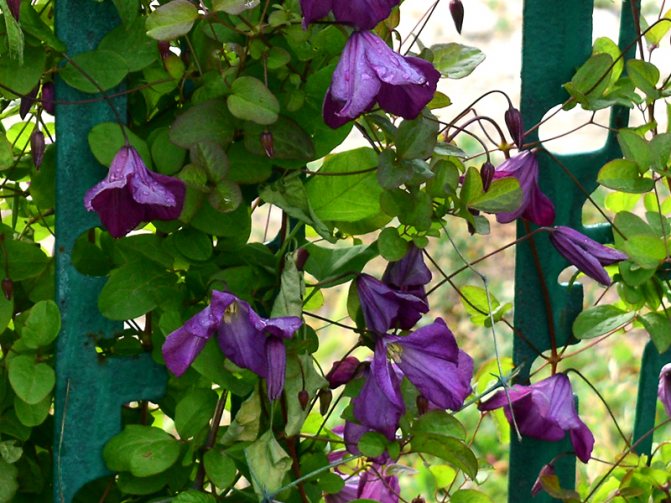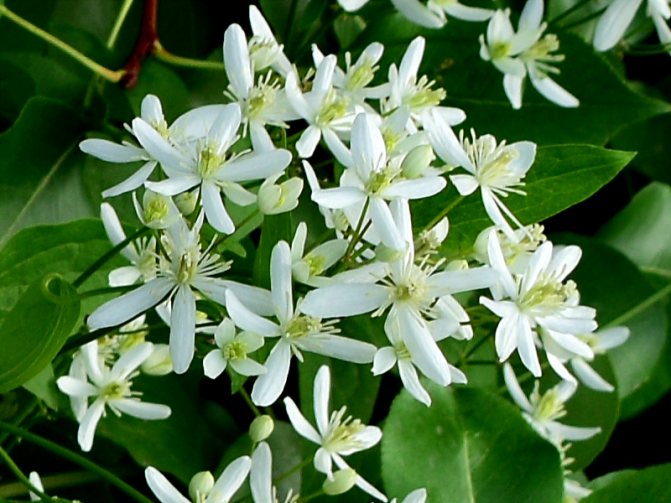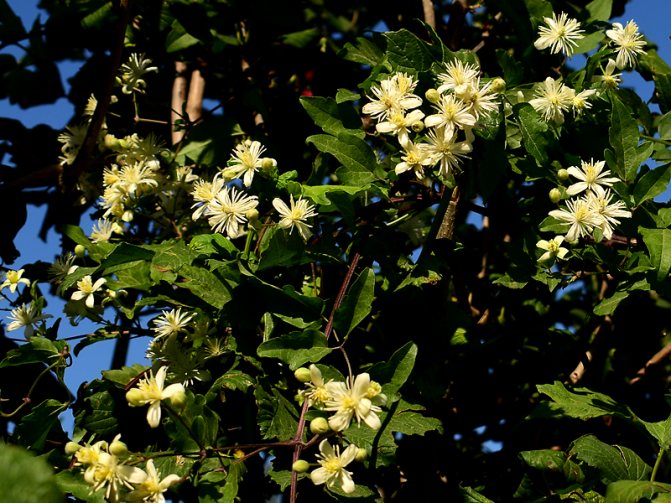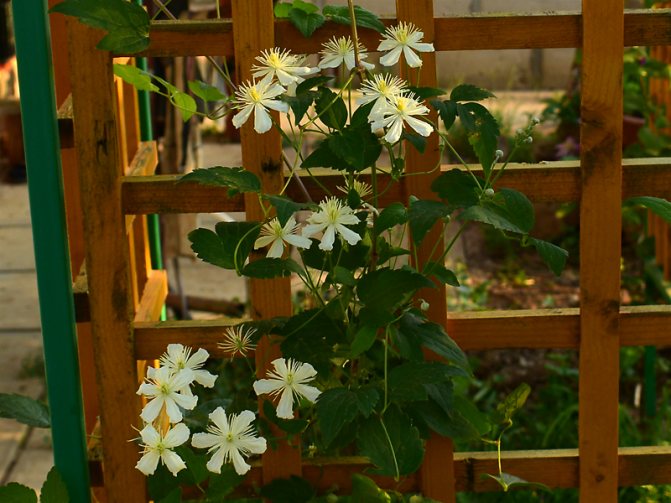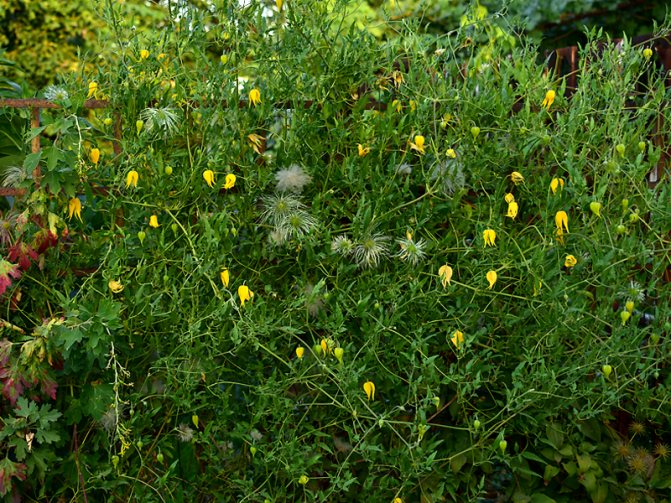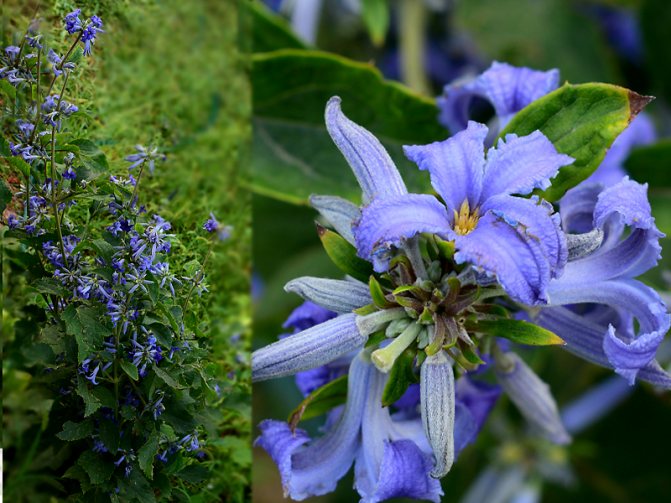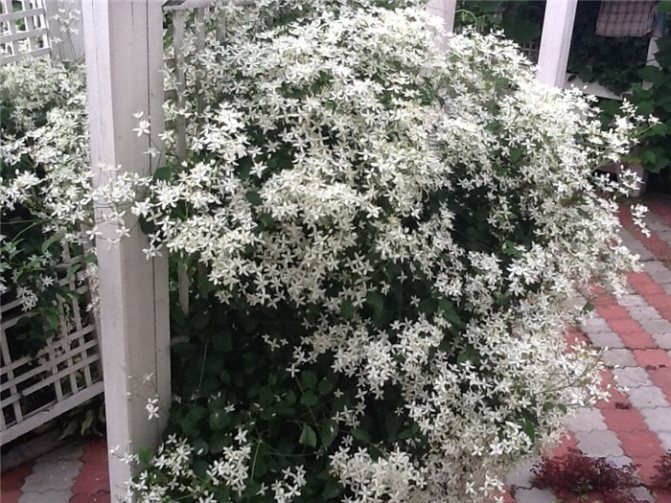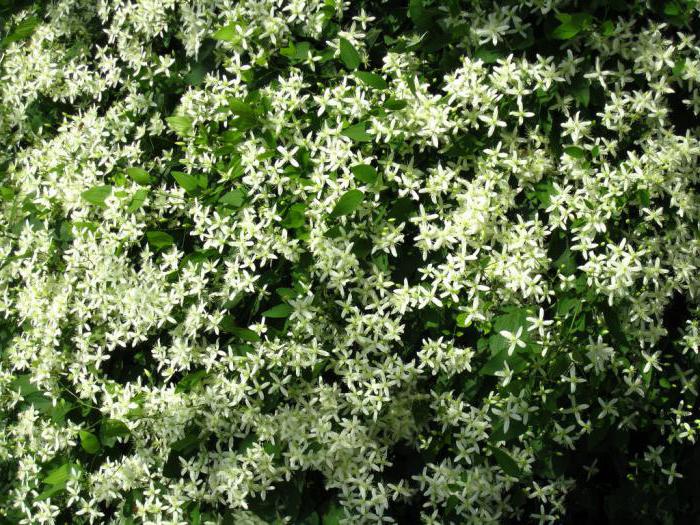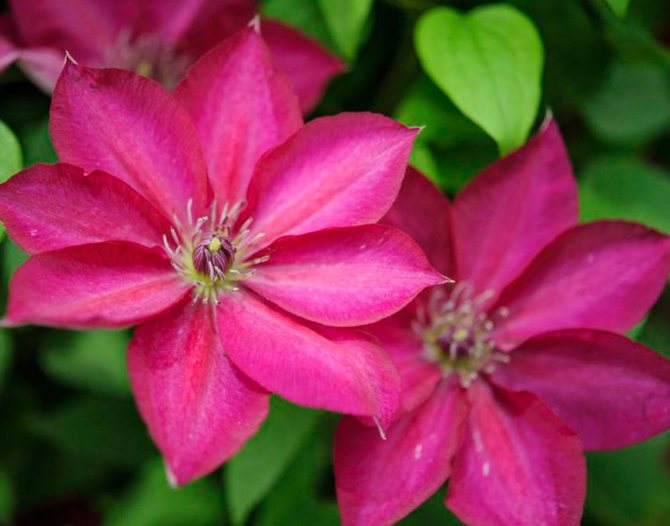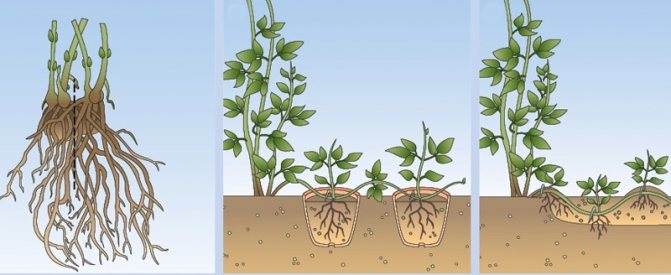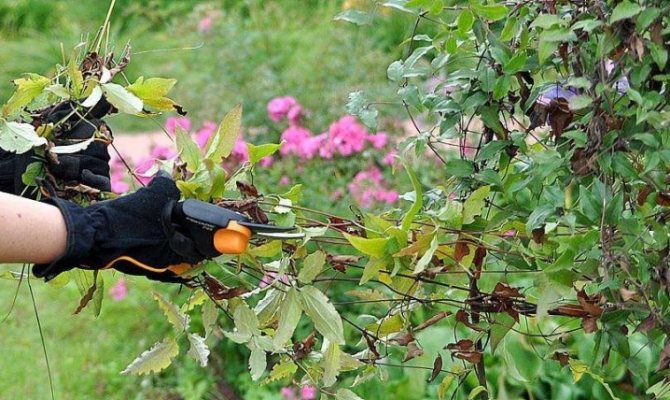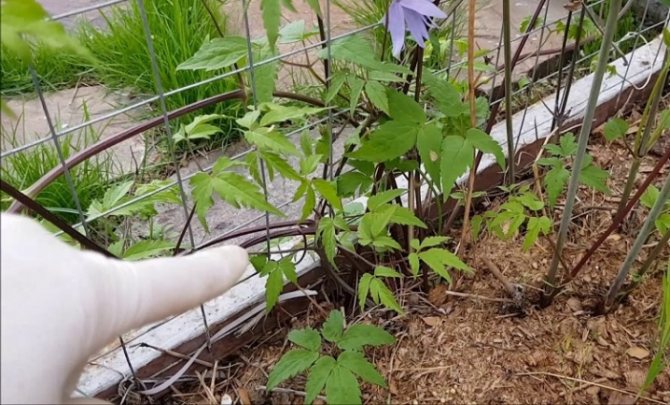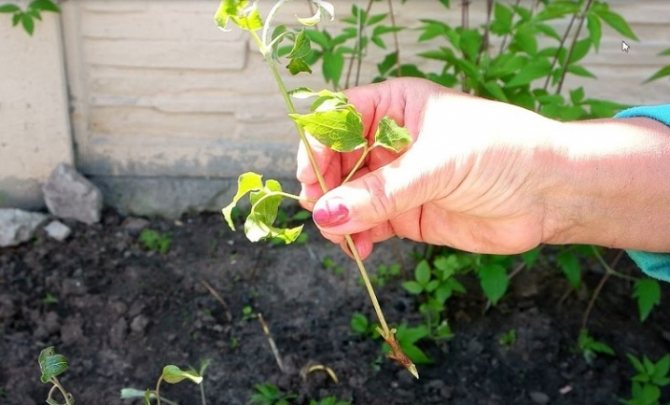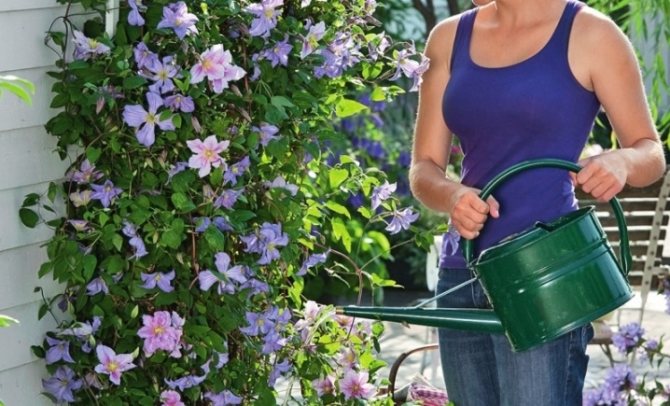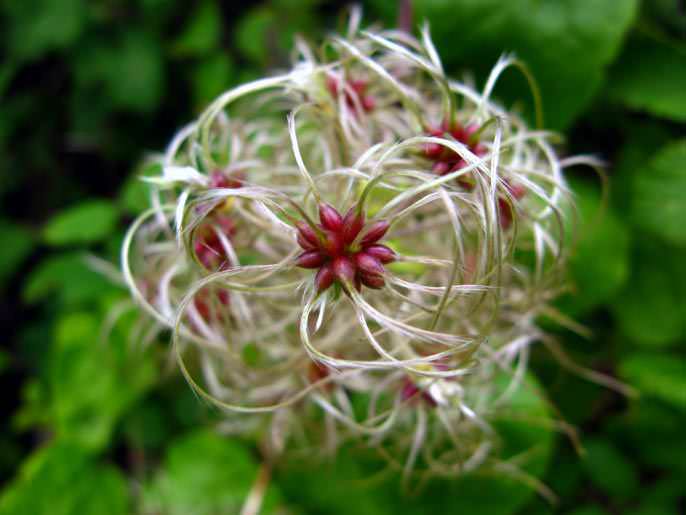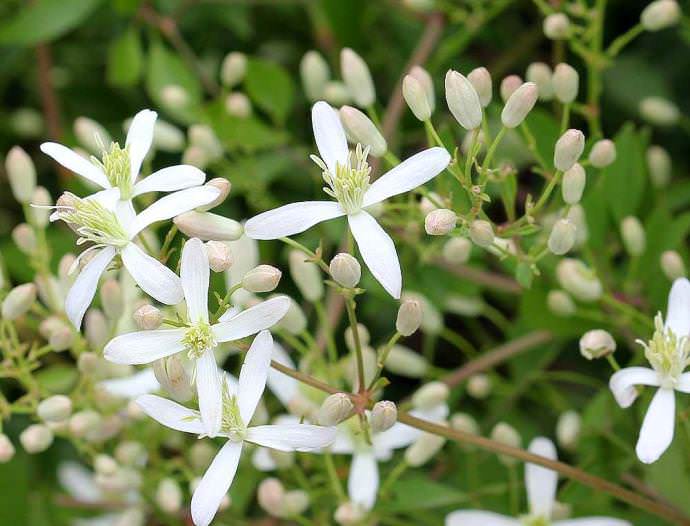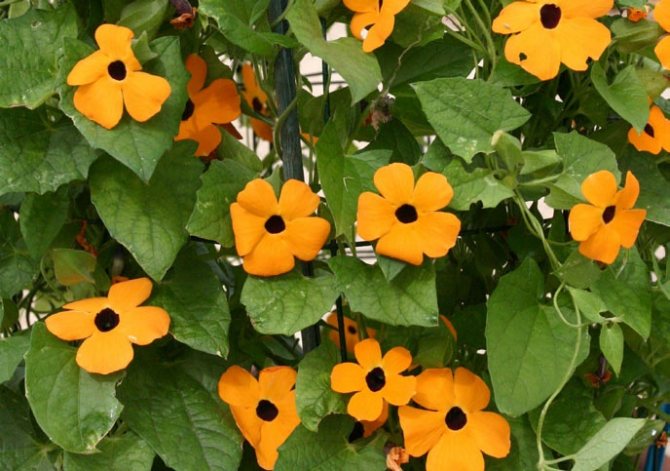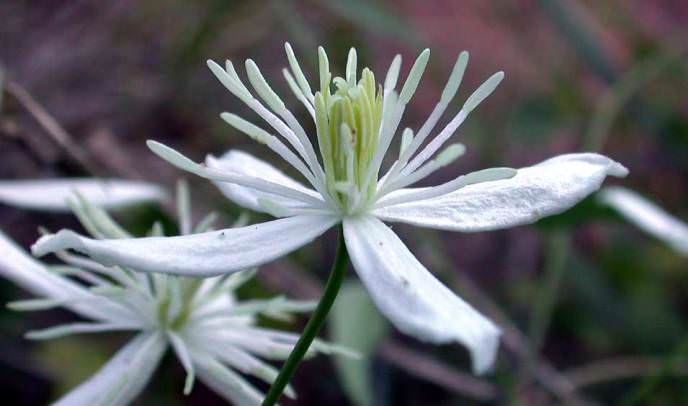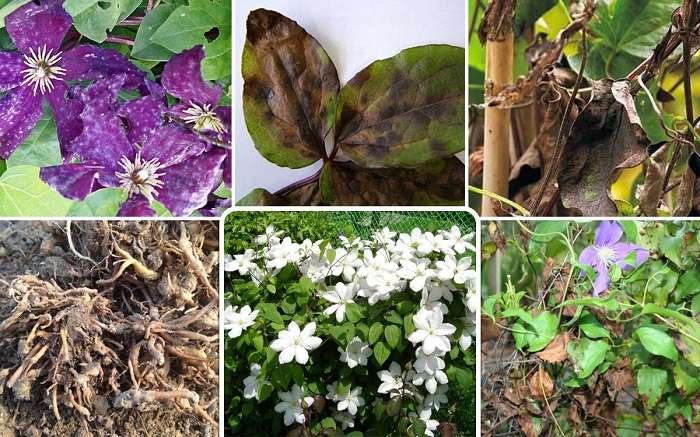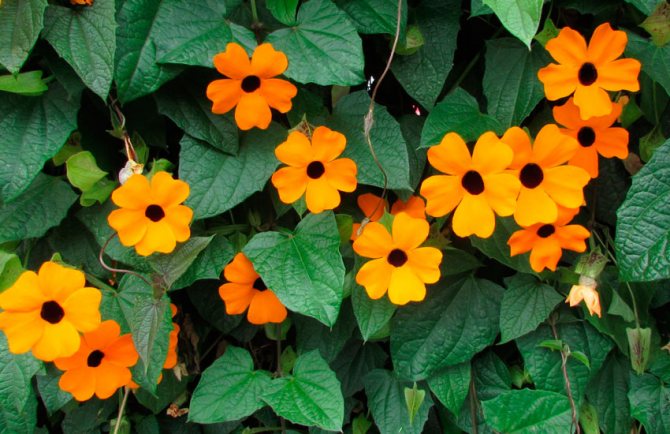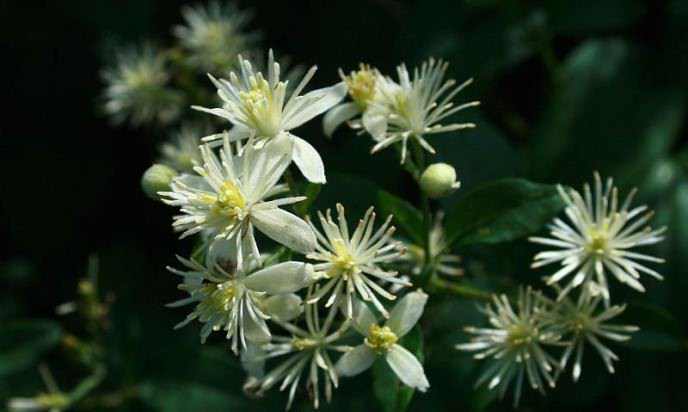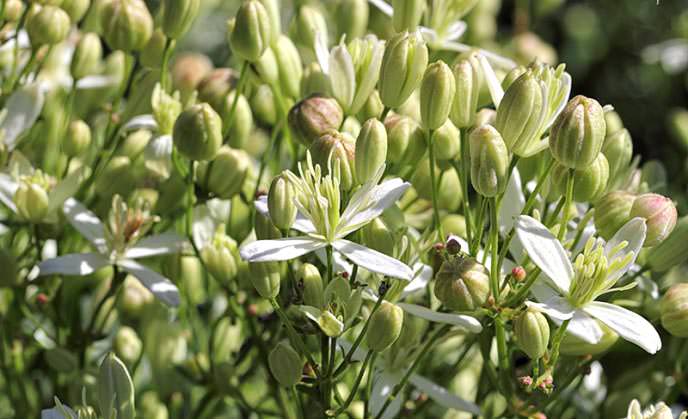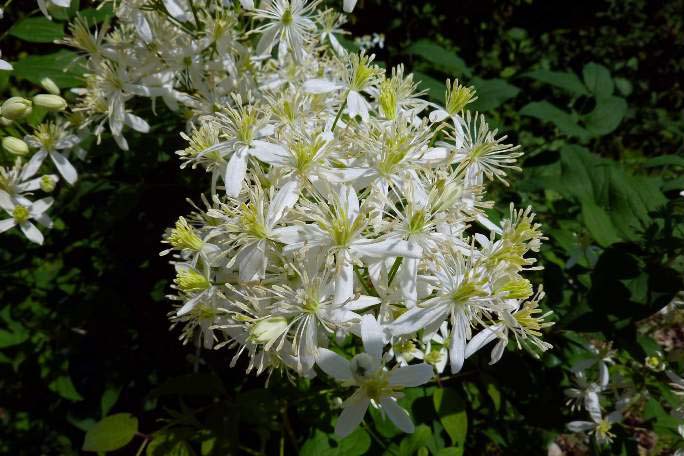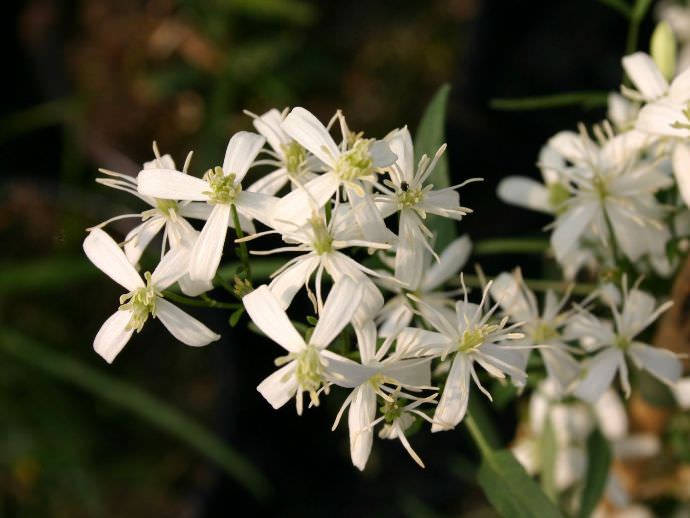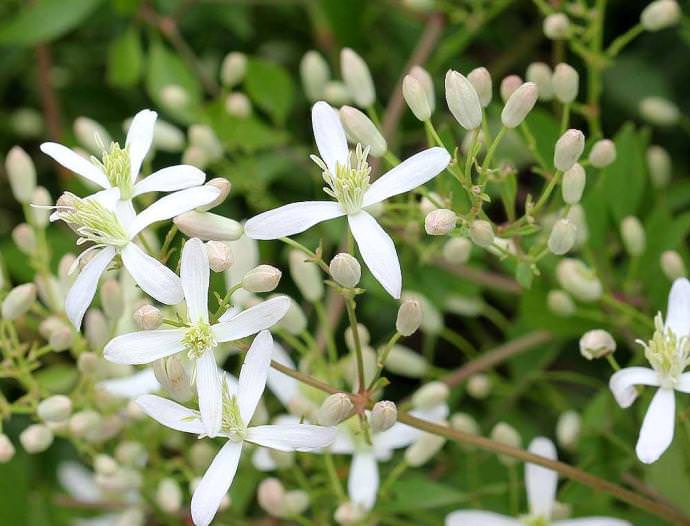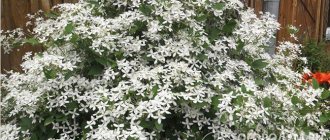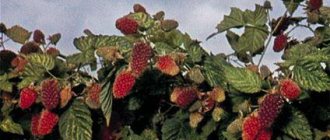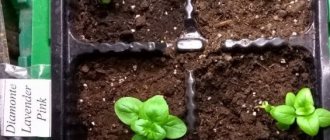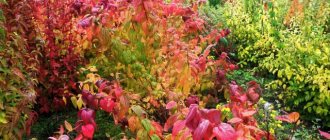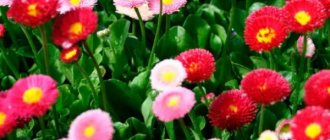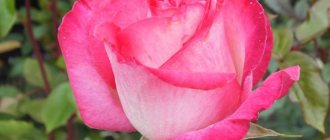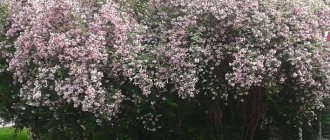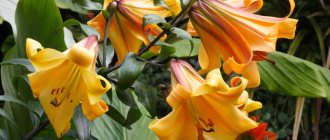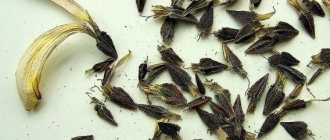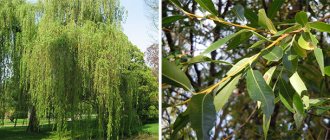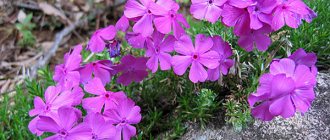Botanical (or species) clematis are still grown by Russian gardeners much less often than their large-flowered "brethren", but one of them is clematis burning small-flowered (white) - still found in domestic dachas. The reason for sympathy for this plant is quite understandable: it is quite unpretentious, it winters well even in regions with a harsh climate, and in terms of decorativeness it has no equal at all.
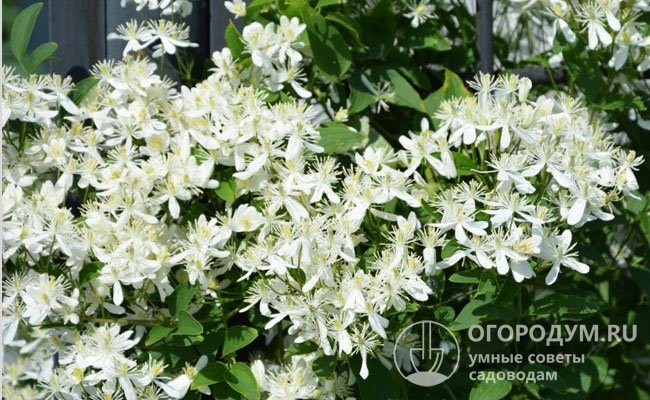
Like all wild species, small-flowered stinging clematis (pictured) is distinguished by its endurance in adverse conditions and resistance to diseases
Today we will get acquainted with this interesting wild liana, discuss its features and the specifics of cultivation in summer cottages. Let's start with the main characteristics:
| Parameter | Characteristic |
| Family | Buttercup (Ranunculaceae Juss) |
| Genus | Clematis |
| View | Burning small-flowered (Clematis flammula) |
| Botanical group | Flammula |
| A type | Small-flowered |
| Life form | Shrub vine |
| Cycle | Perennial |
| general characteristics | Unpretentious, climbing plant |
| Appointment | Vertical gardening |
| Reproduction | Seeds, less often cuttings, layering or dividing the bush |
| Shoot length | Up to 5 m |
| Flower type | Plain |
| Flower diameter | Up to 3 cm |
| Color of petals | White with a greenish tint (yellow anthers) |
| Number of petals | 4 |
| Flowering type | On the shoots of the current year |
| Flowering period | July-August (in the middle lane) |
| Trimming group | Does not need pruning (the aboveground part of the bush dies off in the fall) |
| Disease resistance | Average |
| Frost resistance | High (hibernates without shelter or with light mulching) |
| Registration in the State Register of the Russian Federation | Not registered |
Description of clematis burning
In the natural environment, on the coast of the Black and Mediterranean Seas, clematis burning can reach 3-5 m in height with a diameter of 3-4 m. Clematis prefers forest plantations or thickets of shrubs. In park compositions and private gardens, its dimensions are more modest - up to 1.5 m in height.
Comment! The word "clematis" in translation from Greek means "branch of a vine" or "vine shoot".
Burning clematis (Clematis flammula), also called vine, refers to woody climbing vines. The plant has a fast growth rate, flowers are formed only on the shoots of the current year. Clematis small-flowered white in the photo is very similar to other wild-growing species, such as mountain clematis (Clematis montana) or yellow clematis (Clematis vitalba).
Shoots of clematis pungent rapidly build up green mass. Many small lanceolate or broadly oval leaves 1.5-4 cm long. The color of the leaf plate varies from emerald to dark green, the surface is smooth, with an almost imperceptible waxy bloom.
With the beginning of flowering, which lasts from June to August, the clematis bush is transformed: the liana resembles a light white cloud of hundreds of small stars-flowers. The diameter of the clematis flowers does not exceed 2-3 cm, the sepals are obtuse with pubescence along the very edge, the length is 4-10 mm. Flowers are collected in voluminous airy panicles. One shoot of clematis has from 200 to 400 buds. The flowering of clematis is accompanied by a pleasant, unobtrusive aroma with notes of honey and almonds. At this time, the plant attracts many honey insects.
After flowering on the clematis clematis, you can see red-brown pubescent or naked achenes with a fancy tuft spout up to 7 cm long. Clematis does not lose such an interesting decorative appearance until the end of September.
This type of clematis is called stinging due to a special caustic substance produced by its powerful cord-like rhizome. If it comes into contact with the skin or mucous membranes of the mouth and nasal cavity, it causes irritation, which may be accompanied by swelling. Clematis sap is not poisonous; if precautions are taken during plant transplantation, it does not pose a danger to human health.
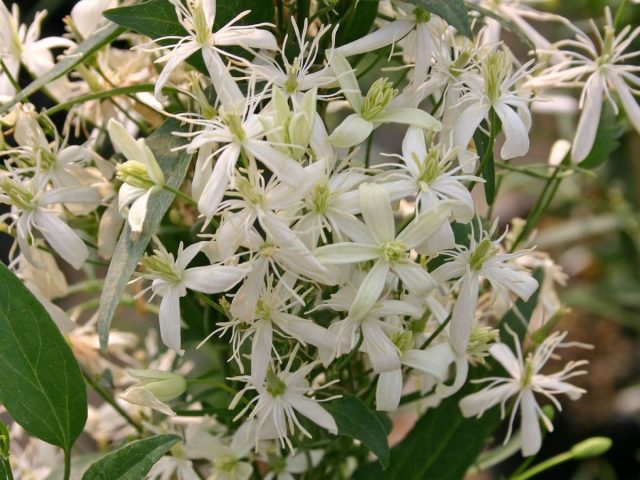

Types and varieties of clematis with photos and names
There are many classifications of clematis. So, they are divided into groups of M.A. Beskaravaynaya, which take into account the origin of the species on the maternal line, use the taxonomic system of M. Tamura, as well as the classification of L. Bailey, A. Raider, V. Matthews and others.
Beginners, as well as amateur gardeners, for the most part use the simplest classifications of clematis according to the size of flowers: small-flowered, medium-flowered and large-flowered. However, the most convenient classification system is as follows:
- group A - flowering is observed on last year's shoots;
- group B - flowering is observed on the shoots of the last and the current year;
- group C - flowering is observed on the shoots of the current year.
Below, these groups will be considered in more detail, as well as the clematis varieties related to them.
First group A
Clematis of the Jacquemann group - their ancestor is the large-flowered Clematis jackmanii. Large shrub vines with shoots 3-4 m long and a well-developed root system. The flowers are large (12-16 cm in diameter), blue-violet-purple tones, odorless.
They are distinguished by abundant and long flowering on the shoots of the current year from June to frost. For the winter, the shoots are cut to the level of the soil or the bases of the shoots are left with 2-3 pairs of buds.
- Varieties: Gypsy Queen, Nikolay Rubtsov, Madame Vilar, Hegley Hybrid, Comtes de Bouchot, Georg Ots, Luther Burbank, Negro.
Today we will briefly present you the most popular varieties of this plant. Grape-leaved clematis is found in the Caucasus and Crimea, Asia Minor, Central and Southern Europe. This is a shrub vine up to six meters long. Flowers are collected in inflorescences with a faint pleasant aroma. Many anthers are yellow.
Clematis burning in landscape design
Snow-white stinging clematis is a great option for creating natural landscapes in a wild style. It is used for decoration:
- walls;
- arbors;
- screens;
- pergola;
- fences;
- balconies;
- bare tree trunks.
If you put a support near the clematis, the plant will quickly braid it, forming lush white-green thickets. Often small-flowered clematis is planted as a full-fledged bush or creeping flower carpet. Burning clematis is used as a ground cover plant in the design of garden paths, flower beds, and coniferous compositions. Combinations of clematis with crops such as:
- spirea;
- juniper;
- undersized varieties of thuja;
- lilac;
- chubushnik;
- rosehip;
- forsythia.
Comment! Mixed plantings of clematis and climbing roses are considered a classic combination in landscape architecture.
Often, eastern clematis and other similar species, contrasting in color, are located next to the burning one. The dense small foliage of clematis, combined with countless small flowers, create a romantic atmosphere in the garden and give the area a cozy and well-groomed property. For joint vertical gardening are also suitable:
- girlish grapes;
- hop;
- ivy;
- actinidia;
- decorative beans;
- sweet pea;
- nasturtium;
- kobei.
Landscape designers often combine burning clematis with perennial and annual herbaceous plants. Good neighbors for clematis will be:
- peonies;
- phlox;
- marigold;
- daylilies;
- irises;
- calendula.
Pruning clematis in the fall
You can prune clematis during the period of active growth, as needed, to prolong flowering, and even before winter. It has already been said above that clematis are divided into 3 groups:
- Group A (first group). Flowers appear on the stems of the last year, in this regard, only weak shoots are subject to pruning. Pruning is done in June when the plant has faded. In late autumn, the bushes need to be huddled high.
- Group B (second group). Flowers are formed on the shoots of the current and last year. Shoots should be shortened to 50–100 cm, leaving 2–5 pairs of buds. Weak stems must be cut to the root. For the winter, it is necessary to remove such a plant from the support, roll it up and carefully put it at the roots.
- Group C (third group). Flowers appear only on young shoots of this year. Pruning of such a vine is carried out several times during the growing season. In autumn, all stems should be cut to the level of the surface of the plot or slightly higher.
We suggest that you familiarize yourself with: Buy a set for drip irrigation Smart Drop Standard at the price of 1,450 rubles. without prepayment cash on delivery
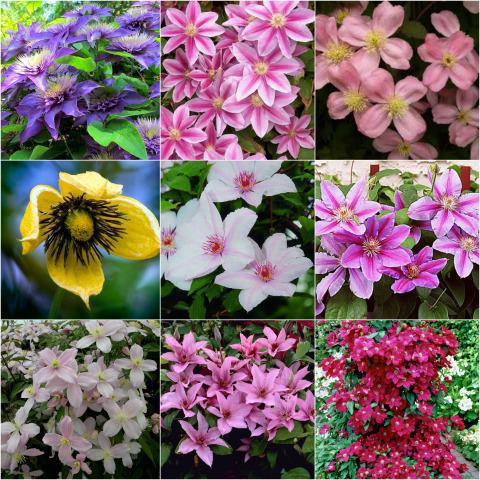

In many ways, the beauty of clematis bushes depends on proper pruning. The first time the shoots are shortened when planting, this is very important for the aerial part. From the lowest buds that were left behind during planting, new shoots grow, which should be pinched in the summer. To prolong flowering, it is recommended to prune some of the shoots in the spring. At the beginning of the summer season, the vines must again be shortened to vegetative buds.
Cutting clematis in the fall is necessary so that the root system develops fully. But pruning should be carried out correctly, taking into account the peculiarities of the flowering of various varieties of this flowering perennial, so that in the next season clematis will delight the owners with active flowering.
When to prune a plant in the fall? As a rule, the process should be carried out no later than 14 - 20 days before the onset of cold weather.
The clematis pruning procedure includes the following varieties:
- sanitary, which removes all damaged or dried branches, as well as all dried flowers;
- formative, in which clematis is given a certain shape, which improves their growth and flowering;
- winter, in which these plants tolerate the cold period better, freeze less.
In our case, the conversation is about the last of the types of pruning. It is clear that cutting off these flowering vines before the onset of frost, it will be easier to cover them for the winter, thereby protecting them from frost. Therefore, it is clear that clematis should be pruned in the fall as a preparation for winter, in order to save them for subsequent development and flowering. In addition, such pruning rejuvenates the flower, in the next season they will have new shoots with flowering buds (not in all species).
Winter pruning, as the name implies, is carried out in late autumn, before the onset of frost. But the formative and sanitary types of pruning can be carried out both in spring and early autumn. But carrying out all types of pruning should be carried out, taking into account the biological characteristics of the varieties of these flowering vines.
Based on the peculiarities of the formation of flower buds on the shoots of these vines and the subsequent flowering, clematis is divided into three main groups.
The first of them (by pruning) includes vines, the buds of which appear on the shoots of the last season. Most often, such clematis of this group are grown in garden plots: Knyazhiki, Hegley Hybrid, Biryuzinka, Cardinal Rouge, etc.


In clematis from the next (second) group, from May to the second decade of July, the buds bloom on the shoots of the last season, and from the second decade of July, flowers appear on the lateral stems that have grown in this season.The most popular varieties are Dawn, President, Fair Rosamund, Flower Ball, Ministerial and some others.
The third group includes varieties, the buds of which appear only on the shoots of the current season. The most popular types of clematis of this group are Ville de Lyon, Cosmic Melody, Victory Salute, Cloud, Gypsy Queen and other varieties of the Integrifolia, Jacqueman and Viticella groups.
You should carefully cut off varieties of vines from the first and second groups, flowers on which appear only on last year's stems - usually the strongest shoots of this year are left, on which buds will appear next season. Usually, the stems are cut at a height of 1.1-1.2 m. At the same time, sanitary pruning is carried out, in which all dry, broken or damaged stems are removed.
But clematis belonging to the third group are cut off almost completely, leaving shoots no more than 18-20 cm long, on which there are no more than 2 buds. From them in the next season, the main and lateral shoots will grow, on which beautiful flowers will appear.
Throughout the season, the plants are constantly cleaned from dried and broken shoots. But pruning them in the fall is especially important.
- Clematis blooms mainly on new shoots, so in the fall, you need to cut off its entire ground part with a long and thin knife, leaving only a couple of nodes. This pruning of clematis makes it easier to care for it in the winter.
- After that, the plants are spud up to a height of 10-15 cm with mulch or dry soil.
- Then they are covered with a box or a layer of peat, sawdust or dry leaves.
- They complete the winter protection of plants by covering them with a film on top. In this case, it is necessary to leave holes on the side for ventilation.
Pruning clematis is done both during the growth of the plant, as needed to extend the flowering period, and for the winter. If you remember, there are three groups of clematis:
- ❶ The first group of clematis (group A). In this group, flowers are formed on last year's shoots, so only weak shoots are cut off. Do this after flowering in June. Before winter, clematis huddle high.
- ❷ The second group of clematis (group B) blooms both on last year's shoots and on the shoots of the current year. Pruning is done at a level of 0.5-1 m, leaving 2-5 pairs of buds, and weak shoots are cut to the base. The liana is removed from the support, folded up and neatly laid at the roots.
- ❸ The third group of clematis (group C) forms inflorescences only on young shoots of the current year, clematis of this group are pruned several times during the growing season. In the fall, all shoots are cut to ground level or slightly higher.
Pruning clematis as an agronomic measure is important.
Sanitary pruning is carried out throughout the season, and dried and broken shoots are regularly removed. By pruning, you can regulate the growth and flowering of clematis. But the main thing that worries flower lovers is autumn pruning. It depends on the type and variety of clematis.
- All varieties of the Jacquemann and Viticella groups. These clematis bloom on the shoots of the current year. Therefore, during autumn pruning, you need to cut off the entire plant, leaving 2-3 nodes above the ground. It is convenient to use a long sharp knife for this operation. Clematis blooming on the shoots of the current year is easier than others to cover for the winter, because there is no need to preserve shoots until spring. Therefore, they are widely used in our gardens.
- Varieties of the Lanuginoza group, or woolly clematis, some varieties of the Patens and Florida groups. Varieties of this group bloom in spring on overwintered shoots, and towards the end of summer - on shoots of the current year. The bush is cut to a height of 50-100 cm from the ground, the lower healthy and ripe shoots are laid on the ground and covered. If the plant needs rejuvenation, then it can be cut lower, to the first true leaf.
- Clematis of the groups Patens (spreading) and Florida (flowering). These varieties bloom only on overwintered shoots.Weak and non-lignified shoots are cut for the winter. The rest are shortened, leaving two-thirds of the height, but no more than 1-1.5 m. The scourges are folded up and laid on the ground under a thorough shelter. The varieties Patens and Florida are the most difficult to winter; if the shoots do not survive or the flower buds freeze, then there will be no abundant flowering this year. But it is the varieties of these groups that give the largest, beautiful, often double flowers, worthy of decorating the gardens of experienced florists. For beginners, we recommend purchasing varieties of the Zhakmana, Vititsella groups and some varieties of the Lanuginoza group.
We suggest that you familiarize yourself with: If you eat a head of garlic a day
Planting and caring for clematis burning
Observing the simple rules of agricultural technology, you can easily grow a white small-flowered clematis in your summer cottage. An optimally selected place, correct planting and subsequent care will provide abundant flowering and decorative appearance of burning clematis for many years to come.
This is interesting: 25 of the best varieties and varieties of garlic
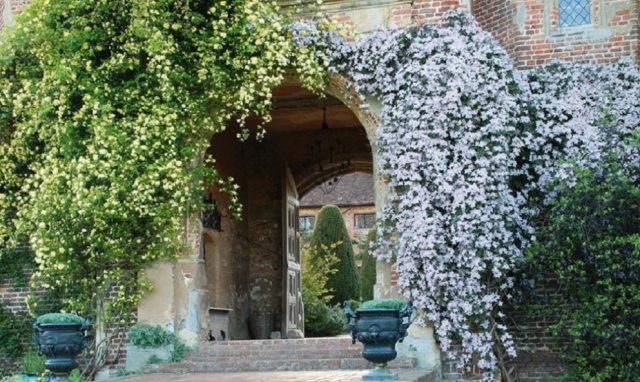

Selection and preparation of the landing site
Clematis can grow in one place for up to 25 years. It can be placed next to outbuildings, near a gazebo or a veranda, arrange an arch or a fence. It is important that the place is calm and well lit, but not located in the sun itself. Planting clematis in partial shade is allowed - this is ideal for hot climates. Gusts of wind are detrimental to clematis, since they easily break young shoots. Decorativeness suffers from this, and the plant looks dejected.
Like other types of clematis, stinging clematis loves loose, light soil that is rich in nutrients. The pH reaction should be neutral or slightly alkaline. In acidic soil, before planting clematis, lime should be added.
Comment! Best of all, small-flowered clematis grows on loam and sandy loam.
Burning clematis does not tolerate the close occurrence of groundwater, it is not recommended to plant it in lowlands and in swampy areas. Excess moisture will inevitably lead to rotting of the root system. Some gardeners get out of the situation by digging special drainage ditches in the immediate vicinity of clematis plantings. During lingering rains, wood ash is scattered under the bush.
A pit for clematis is dug in advance. Garden soil is mixed with the following ingredients (per 1 m²):
- wood ash - 300 g;
- superphosphate - 150 g;
- peat - 10 l;
- humus - 20 liters.
The dimensions of the depression depend on the dimensions of the root system of clematis, but not less than 60 cm in width and length, depth - 70 cm.Immediately before planting, the soil can be shed with a weak solution of potassium permanganate.
Seedling preparation
A well-chosen planting material is a guarantee of health and abundant flowering of clematis. When examining seedlings in a nursery, you should pay attention to the following nuances:
- the plant should not have mechanical damage;
- pests and signs of any diseases should be absent;
- the root system must have at least 5 roots;
- an autumn clematis seedling should have 2 shoots, a spring one - at least one.
The best time to buy young clematis is mid-September. 2-year-old seedlings with a closed root system have the greatest survival rate. Before planting, the shoots of clematis are cut off, leaving 1-5 buds.
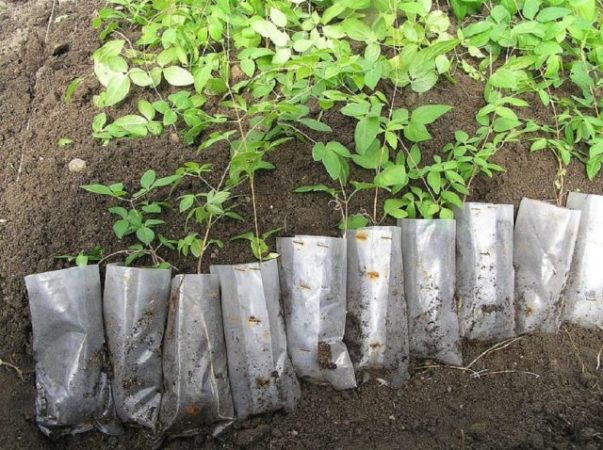

Rules for planting clematis burning
Burning clematis is planted in open ground in spring or early autumn. In areas with a temperate cool climate, spring planting is more appropriate, in the south - on the contrary, autumn planting. Planting clematis burning is not difficult, however, you need to follow a few rules:
- A support is installed at the bottom of a previously dug hole and covered with a layer of drainage from pebbles, broken brick, crushed stone, expanded clay or coarse river sand.
- A layer of fertile soil is laid on the drainage in the form of a mound, on which a seedling is installed, spreading the roots.
- Young clematis is covered with earth so that the root collar is 10 cm below ground level, and something like a funnel or crater is formed around it.
- A clematis seedling is abundantly watered with warm, settled water and mulched with a generous layer of peat.
- In the first weeks after planting, clematis is shaded from direct sunlight.
Important! The distance between adjacent clematis bushes should be at least 1 m.
Watering and feeding
Clematis small-flowered burning loves moisture, you need to water the liana once a week, and on hot dry days - 2-3 times. To do this, it is better to use a watering can without a diffuser, pour water under the root, trying not to get on the leaves and stems. Inaccurate irrigation of the ground part of the clematis can lead to its wilting. Young clematis bushes consume much more moisture than adult perennial vines.
In order for clematis burning to please the gardener with lush and juicy foliage, as well as abundant and long flowering, it must be fed in a timely manner. During the active growing season, organic and mineral fertilizers are applied alternately to the soil around the clematis, observing an interval of 20-25 days.
Nitrogen and its compounds, which are so necessary for active growth, are contained in organic matter (manure, chicken droppings). They are mixed with water and infused - this promotes better absorption of nutrients by the roots of the plant. In the absence of droppings or manure, burning clematis can be fed with urea (urea).
To ensure high-quality bookmarking of buds and lush long flowering, Clematis pungent is fertilized with a complex mineral agent, for example, nitrophosphate.
When clematis burning begins to bloom, they try not to feed it, especially with products containing a large amount of nitrogen. This will provoke the vine to build up its green mass to the detriment of flowering. When the clematis clematis fades, potassium-phosphorus fertilizers are applied to the root zone. It is better to feed the vine immediately after the next watering.
Advice! In order to prevent diseases and to increase immunity, foliar feeding of clematis is performed with a solution of boric acid and potassium permanganate. Take 2-3 g of potassium permanganate and 1-2 g of boric acid per 10 liters of water.
Mulching and loosening
To increase the air permeability of the soil, the near-stem circle is periodically loosened, while removing weeds. The procedure should be carried out after watering or rain. So that moisture from the soil surface evaporates less, burning clematis is mulched with sawdust, humus, peat or fallen leaves. Several times per season, the mulch layer is changed to a new one.
It is interesting: Black currant: features of planting and crop care
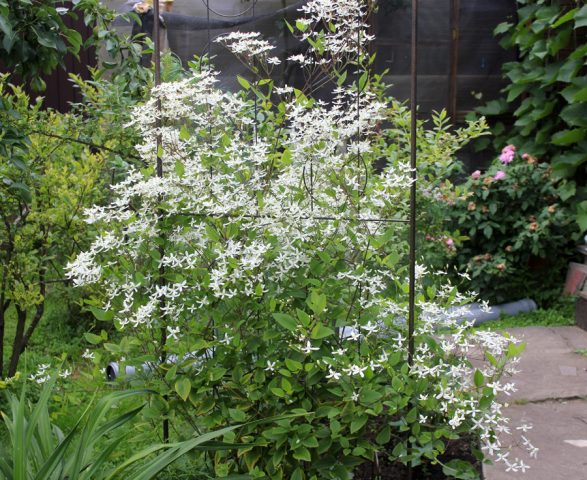

Garter
Young fast-growing shoots of clematis burning are characterized by increased fragility and need timely garter to support. To do this, use raffia, twine or plastic clips. The lower part of the clematis bush is fixed to a mesh or wooden structure with a wire. Lianas are tied up in one layer so that light and air can easily penetrate to any part of the plant. Otherwise, clematis clematis will suffer from various diseases caused by lack of light and high humidity.
Pruning
In the spring, for a more spectacular and long-lasting flowering, several side shoots are cut from clematis. Dried or damaged branches are removed throughout the warm season. To do this, use a well-sharpened garden pruner, disinfected in a solution of potassium permanganate or alcohol. In the fall, a cardinal pruning of all clematis shoots is carried out, leaving only a few nodes above the ground.
Preparing for winter
After the autumn pruning, the near-stem circle is spudded with mulch or dry earth, a wooden box is placed on top, covered with a thick layer of sawdust, peat or leaf litter.A thick plastic wrap with holes made in it for ventilation is fixed on the shelter. In this form, the rhizome of pungent clematis will calmly endure even the most severe and snowless winter.
Reviews of summer residents
Irina, 61 years old, Moscow region
I have long wanted a small-flowered species clematis, but the prices for seedlings are kept at such a level that I have postponed the purchase for several years. In the year before last, I still could not resist: I wrote out "burning" by mail. In the first summer, he did not bloom, only grew a few stems about a meter long. But in the second year I already had a small blooming "cloud" with an absolutely incredible aroma. The plant turned out to be very cute and completely hassle-free. When I was very young, I carefully watered and fed him, but last summer I had to leave the dacha for two weeks in the very heat. I was very worried about clematis, I was afraid that it would dry out without watering. However, everything worked out: not even the leaves wilted on it. A good vine, there is very little work with it. And before winter, you do not need to cut or cover. In general, I am pleased with my purchase.
Victor, 55 years old, Kursk
On our site, clematis burning has been growing for more than 15 years (inherited from the previous owners of the dacha). The blank western wall of the house is completely covered in summer, as if a white blanket was hanging. There are practically no worries with him: in the fall, remove the dry mass of branches and leaves, and in the summer, make sure that the bush does not thicken. We water it only in a big drought, we feed it occasionally, and that's it. The seeds on the bush are always the sea, they look very beautiful. Several years ago, they began to notice that in the spring they sprout like a "self-seeding" both on our site and on the neighboring ones. So now we have our own planting material, and without any hassle. We sit along the fences and give to friends.
Margarita, 57 years old, Ryazan
A seedling of this species was presented to me 5-6 years ago. They bought it like Manchurian, but it turned out to be burning (a re-grade happened). At first I was upset, but now I don’t regret it. A flowering bush of amazing beauty! I have it growing near the gazebo, the backdrop for a red climbing rose. It looks very cool, and the aroma during flowering is such that the bees swarm around the site all day. Now I want to make layers of clematis. Then I will plant them near the fence, so that in the summer it will be beautiful there too. Such a decorative and easy-to-care vine is rarely seen. I recommend to everyone!
Reproduction
Clematis pungent can be propagated both vegetatively and generatively. Each method has its own advantages and disadvantages:
- Seeds. Clematis small-flowered white is a natural species, therefore seedlings grown from seeds will exactly repeat all the characteristics of the mother plant. The future seed is collected from the clematis at the end of October. The seeds are cleaned of fluff and tuft, placed in containers with wet coarse sand and refrigerated for 2-3 months for stratification. In April-May, clematis seeds are sown in a sand-peat mixture on the surface of the soil, sprinkled on top with a thin layer of sand. Seedling care is reduced to regular watering. When 2-3 true leaves are formed on young clematis, they can be dived into separate containers. The bushes will be ready for transplantation to a permanent place in the garden only next spring.
- Layers. In the spring, near the clematis bush, they dig a shallow groove in which a strong healthy liana is placed and fixed with special metal brackets. After the appearance of new shoots on the layering, it is slightly buried in earth. A year later, the allotted shoot is carefully removed from the ground and cut into separate seedlings, which are immediately determined to a permanent place.
- Cuttings. Both green and lignified clematis shoots are suitable for cuttings. They are cut with a length of 8-10 cm so that the upper cut above the knot is straight, and the lower one is at an angle of 45 °.The leaves below the node are cut off, the tips of the cuttings are treated with a growth stimulant (drugs "Kornevin" or "Heteroauxin") and planted in a greenhouse, in a loose nutritious substrate. After 1.5-2 months, the root system of young vines will be ready for transplantation to a permanent place or to growing beds.
- Division of the bush. An adult burning clematis is dug in from all sides or taken out of the ground completely. The bush is divided into several parts so that each has a good rhizome and several shoots with vegetative buds. Clematis plots are immediately planted in a permanent place.
Choosing a landing site
Like other varieties of clematis, Clematis pungent prefers light, nutritious soils. Good drainage from broken bricks, pebbles, expanded clay or river sand is required. The plant does not tolerate stagnation of moisture in the soil - with an excess of water, the roots and bases of the stems begin to rot, and the entire vine may die. Do not place clematis in low-lying areas or on swampy soils. Better to plant them on a small, well-lit hill. Small drainage ditches can be dug to drain the groundwater.
Ideal soil should be neutral or slightly alkaline. It is recommended to process acidified soil with lime, and then mix it with sand, peat and old humus. For the prevention of diseases, the soil before planting the plant must be watered with an aqueous solution of potassium permanganate. This simple procedure will protect delicate shoots from pests and various diseases.
It is best to plant the vine in front of the wall of the house, near a strong fence with an arched support, next to a gazebo or summer kitchen. Like other varieties of clematis, white small-flowered does not tolerate sudden gusts of wind, which can break fragile young shoots and damage inflorescences. The site should be well lit, light partial shade is possible in the afternoon. Protecting the plant from the sun is necessary only in arid southern regions. You should not plant clematis under the canopy of old trees, where the sun's rays do not penetrate well. But the liana will gladly braid a dried trunk or a high stump, creating an original blooming composition.
Diseases and pests
Clematis burning most often suffers from fungal infections. Clematis pests are:
- aphid;
- bear;
- slugs;
- snails;
- root knot nematode;
- caterpillars;
- spider mite;
- rodents.
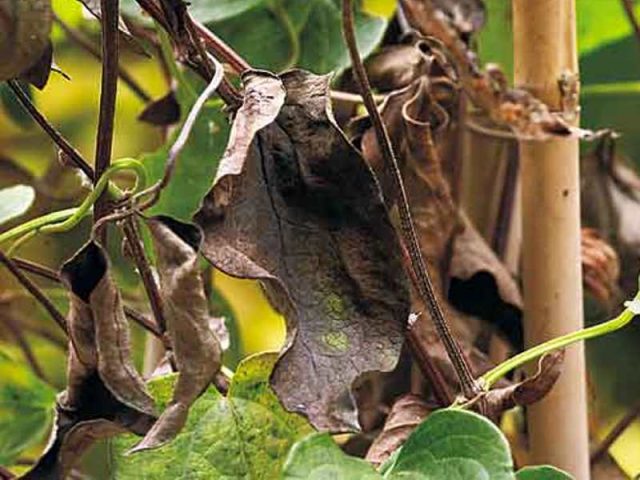

The table below describes the most common diseases and pests of clematis, as well as control and prevention measures.
| Disease or pest | Description | Control and prevention measures |
| Rust | Rust on burning clematis appears as red spots on young shoots, petioles and leaves. In the absence of treatment, the shoots are deformed, the leaves turn brown and curl, which subsequently dry out and fall off. | For the purpose of prevention, weeds should be weeded in a timely manner and the affected fragments of the vine should be cut off. When clematis is infected with rust, a 1% solution of Bordeaux liquid, copper oxychloride (HOM), preparations "Topaz", "Gamair" |
| Gray rot | In cloudy and rainy summers, the leaves and petals of clematis can be covered with brownish spots with a gray down. These are the first signs of gray mold infection. Over time, young shoots and leaves die off, clematis stops growing. Spores of the fungus Botrytis cinerea are easily carried by the wind and quickly infect other horticultural crops | Waterlogging of the soil near clematis should not be allowed. To combat the bushes of burning clematis are treated with the drugs "Azocene", "Gamair", "Fundazol" |
| Powdery mildew | At the height of summer, clematis burning can affect powdery mildew. Leaf plates, green shoots, flowers and buds are covered with a gray-white bloom, reminiscent of flour. Affected fragments quickly change color to brown and die off | Preventive measures against powdery mildew - timely watering without waterlogging, treatment of clematis plantations with cow's milk diluted in water. For treatment, use "Fitosporin-M", "Topaz", "Baktofit", "Alirin-B", soda ash diluted in water (40 g per 10 l) |
| Verticillium wilt (wilt) | The first sign of wilt on clematis is the wilting of the top of the shoots, especially the young ones. This is the result of the activity of pathogenic fungi that live in the soil and, under favorable conditions, penetrate the stems of the plant. Vessels in the core of the stem are damaged and clogged by the mycelium of the fungus, nutrients are supplied in insufficient volume. The disease spreads very quickly - several lashes can dry out in a day | Do not plant clematis stinging in a shaded area with heavy and acidic soil. It is important to tie up clematis in a timely manner, remove weeds and not overfeed with nitrogen. The peak of fungus activity occurs at a temperature of 23-26 ° C and an increased level of humidity. The bushes of clematis pungent are treated with a 1% solution of copper sulfate, "Trichodermin", "Glyokladin", copper-soap solution. In some cases, it is not possible to save clematis, it is dug up and burned |
| Aphid | In early summer, aphids are activated on the tops of young shoots of clematis. Numerous small insects literally stick around the clematis, sucking out the plant sap and secreting a sticky liquid. Gradually, the shoots dry out and die off | Aphids are removed from burning clematis mechanically (by flushing with a stream of water), they attract beneficial insects and birds to the garden, use folk methods (spraying with infusions of tops of tomatoes, garlic, onion husks). The most effective is the use of modern bioinsecticides, such as "Fitoverm-M" |
| Snails and slugs | With the arrival of the warm season, clematis burning is attacked by slugs and snails. They eat the soft tissues of clematis, in particular the kidneys. | Pests are collected by hand, wood ash, lime, superphosphate, granular metaldehyde are used to scare off and fight |
| Spider mite | You can notice that clematis stinging is affected by a spider mite, it is possible by the presence of a sticky thick cobweb on the leaves and shoots. Ticks pierce the clematis leaf plate from the underside and feed on the plant sap. Small yellow spots appear in these places, over time, the affected fragments lose color and dry out | Ticks become active in hot and dry weather, usually in the middle of summer. It is difficult to get rid of the pest, you will have to treat the ground part of the burning clematis three times with strong insecticides, such as "Aktellik", "Akarin", "Antiklesh" |
| Gall nematode | The nematode roundworms infect the root system of clematis, provoking the formation of thickenings that disrupt the normal nutrition of clematis. Liana looks depressed, pale, growth slows down. Young seedlings of clematis pungent may die | Pests are deterred by planting marigolds and calendula. And also mulching the clematis tree trunk circle with mint or wormwood. It is necessary to add compounds containing ammonia (ammonium nitrate or ammonium sulfate) |
This is interesting: how to grow stevia at home
Watering and feeding
Clematis pungent during the growth period needs good watering. In dry weather, watering is not often, but abundant. Clematis needs four times (per season) fertilizing with mineral fertilizers, which is done after watering. To protect the root system from overheating, it is advisable to plant the bushes with annuals.
Clematis pungent begins to bloom profusely in the sixth year. Until this moment, only a few flowers appear, which should be cut off. From the age of three, shoots grow at the bush.
Lighting
Clematis burning, caring for which is not difficult, is a photophilous plant. If it lacks light, the owner may not see the luxurious bloom.Therefore, in the middle lane, it is advisable to plant this vine in a sunny area or in a slightly shaded place. Only in the south, where these vines suffer from overheating of the soil, should they be planted in partial shade. The wind is a terrible enemy of clematis: it damages flowers, breaks shoots.
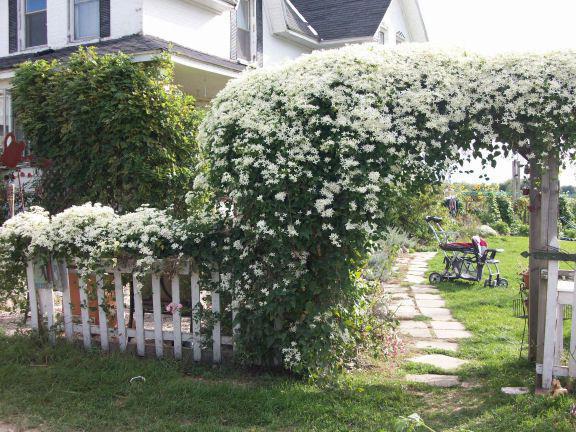

1. Seven Secrets of Success:
| 1. Growing temperature: during the growing season, cultivation at normal room temperature in the range of 16 to 24 ° C. The winter dormant period of clematis should take place at a temperature of about 5 ° C. |
| 2. Lighting: the green mass of the flower should bathe in the sun for 3 to 4 hours daily - morning and evening, while the roots should remain in the shade. |
| 3. Watering and humidity: Abundant watering during the growth and budding period with drying the top layer of the earth between them, in autumn and winter, reduce the frequency of watering to a minimum, simply protecting the substrate from completely drying out. It is desirable to increase the air humidity. |
| 4. Pruning: Formative pruning is carried out depending on the type of flower at different times and with different degrees of intensity. |
| 5. Priming: loose, moisture and air permeable substrate with a high organic content. |
| 6. Top dressing: in spring and summer with organic and mineral fertilizers 2 times a month. In autumn and winter, you do not need to feed the flower. |
| 7. Reproduction: Clematis propagates by sowing seeds, grafting, stem cuttings and, quite often, by air layers. |
Botanical name: Clematis.
Clematis flower - family... Buttercup.
Homeland of the plant... China, Japan.
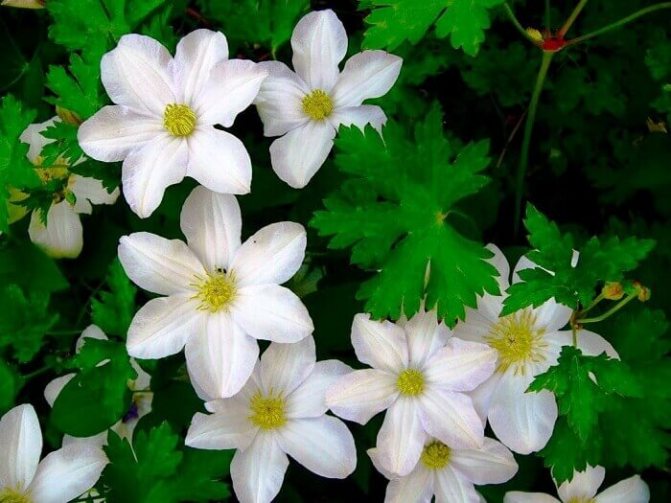

Description... Clematis or clematis is a large group of delightful, flowering shrubs and vines in the widest variety of shapes and colors, and can be evergreen or deciduous. The stems are brown, woody with age, often brittle, up to 6 m long. Long leaf stalks twine around the support and help the plant climb up. Leaves are simple or palmate - dissected, arranged opposite or alternately, green, gray-green or blue-green. Depending on the variety, flowers appear from spring to autumn, flowering occurs 1 or 2 times a year, there are also continuously flowering varieties that delight with flowers from spring to autumn continuously. The color scheme is very diverse and includes shades of pink, red, white, light blue, burgundy, blue and purple. Flowers can be simple and double, up to 12 cm in diameter.
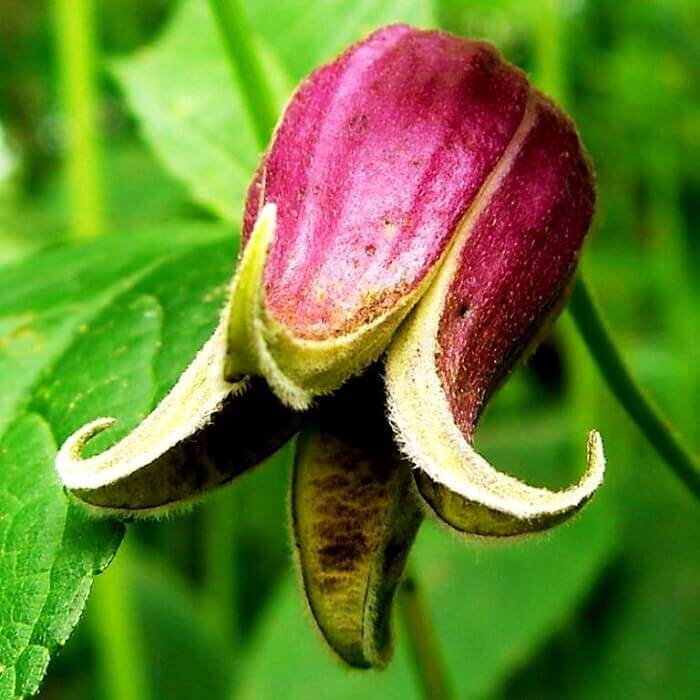

Height... Shoot length up to 6 m.
Principles of pruning plants of the second group
The second group of clematis pruning differs from the first in that the buds of this plant bloom twice per season, both on new shoots and on last year's. The first short flowering period occurs in late May or early June. The buds bloom on the shoots left over from the last season and successfully survived the winter. The flowers are quite large, but they are located quite rarely, due to their small number. Those clematis that bloom in this way are usually called hybrid.
The next flowering period is longer, starting in July and ending in autumn. Unlike the first flowering, the buds that appeared at this time are scattered over the bush quite densely. Flowers originate from shoots formed in the current season. The varieties Patens, Queen, Blue Ice, Freda, Florida, President, Lanuginosa are considered widespread.
When to prune clematis of the second flowering group? In order for the plant to bloom as long as possible, to successfully endure the cold, it is necessary to cut it in 2 stages: after the first wave of flowering and before sheltering for the winter. If pruning for the winter is carried out in one step, then the plant will not have time to sufficiently prepare for the frost, as a result of which it may not withstand the cold weather and die.
Branches with buds that have blossomed in the first period are cut off as soon as their flowering ends, i.e. towards the end of June.
- Shoots with flowers formed during the second wave of flowering are pruned before the shelter for the winter.


Pruning scheme by year
How to plant clematis (video)
Clematis burning is one of the most common and popular types of clematis in domestic gardening. It attracts with good frost resistance, unpretentiousness and durability, long flowering. The use of this plant in garden decoration is extremely diverse, its flowers are beautiful and fragrant.
Introduction
In order to grow clematis in your garden or on a plot, you need to know as much as possible about it, and in this article we will just tell you in more detail what clematis is. We will also touch on the most popular varieties of clematis, talk about the basic rules for planting clematis and the subsequent care of it. This article will be quite interesting for both experienced gardeners and those gardeners who do not yet have experience in growing this incredible flower, but at the same time would like to receive as much useful and relevant information about it as possible.
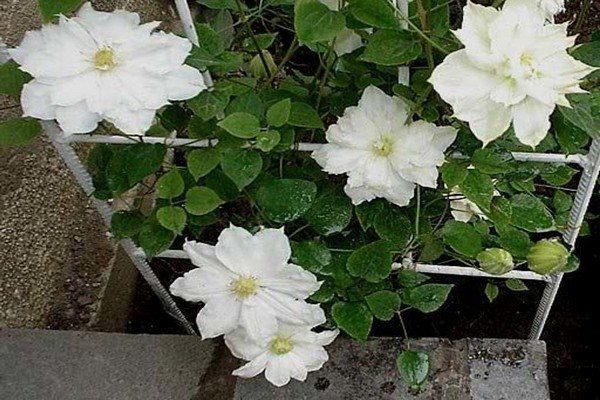

Support
In order for clematis burning to develop normally, to bloom for a long time and abundantly, it needs support. It is desirable that it is not only practical and convenient for the bush, but also beautiful. Sometimes clematis is supported by weigela, forsythia or chubushnik bushes. The shoots cling to them, stretch up, hang freely, and by the middle of summer the shrubs are completely hidden under the magnificent flowers. An arch or a screen can be an excellent support for clematis.
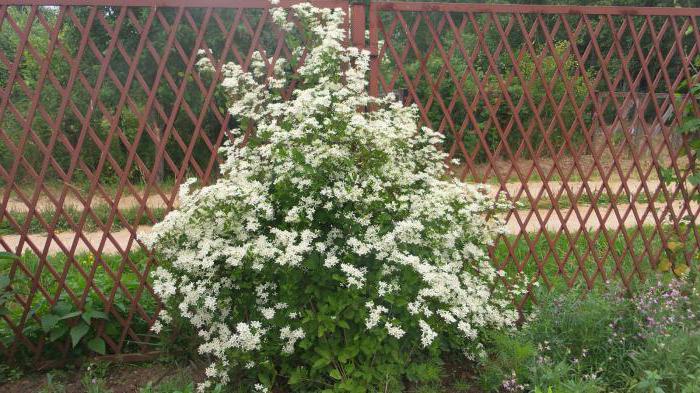

Potential problems during cultivation
When breeding clematis, the following problems may arise:
- the vine stops growing after reaching a certain mark;
- flowers begin to become smaller and smaller with each season;
- drying of the tops.
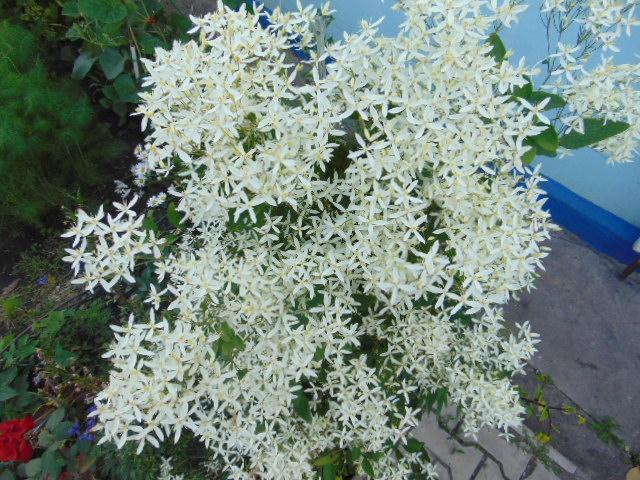

Stagnant growth
The problem arises in the first year of life, when the vine literally stops its development, at around 20-30 centimeters. The reason for this behavior lies in the violation of the plant care regime by the gardener. Reinforced groundbait with nitrogen-containing fertilizers and abundant watering will help to correct the situation.
Chopping flowers
This problem is characteristic of old bushes with large flowers (for example, the White Cloud variety), the age of which reaches 5 years and more.
This is due to the fact that the roots grow deep into the soil, and watering does not provide the plant with a sufficient portion of moisture, weakening it.
To fix the problem, dig a few plastic bottles with a cut-off bottom, neck down, into the ground, at a distance of 50 centimeters from the base of the bush. Water is poured into them, thereby contributing to its deeper penetration into the soil.
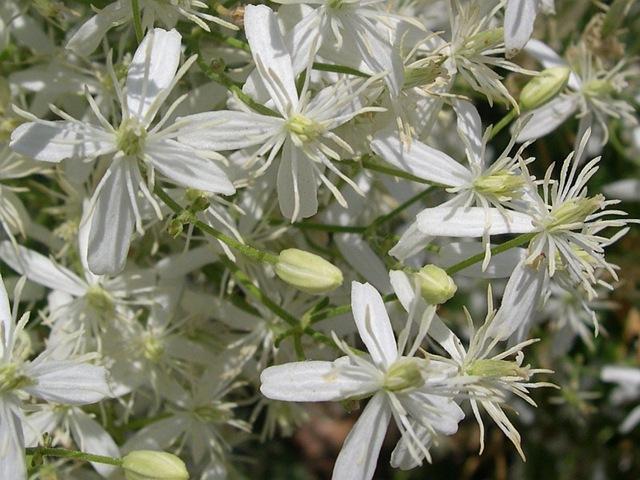

Drying tops
The cause of the problem is insufficient moisture. Similar symptoms occur when aphids appear on the vine. The first problem is eliminated by increased watering, the second - by spraying with special means from parasites.
Why does not it bloom
- Incorrect fit... The site must be selected correctly and the planting pit must be properly prepared.
- Lack of light... In areas that are too shaded, Clematis does not bloom well.
- The plant is weakened by diseases or pests. It is necessary to carry out preventive spraying and regularly inspect plants for the timely detection of diseases and pests.
- Incorrect feeding... Lack or excess of nutrients are equally harmful to the plant.
- Incorrect cropping... It is important to take into account that Clematis burning blooms on the shoots of the current year, therefore only the shoots of the last year are pruned in the spring.
- The plant is too young or old... Seedlings grown from seeds bloom only for 3-4 years. The old plant must be replaced with a young one.
Water abundantly
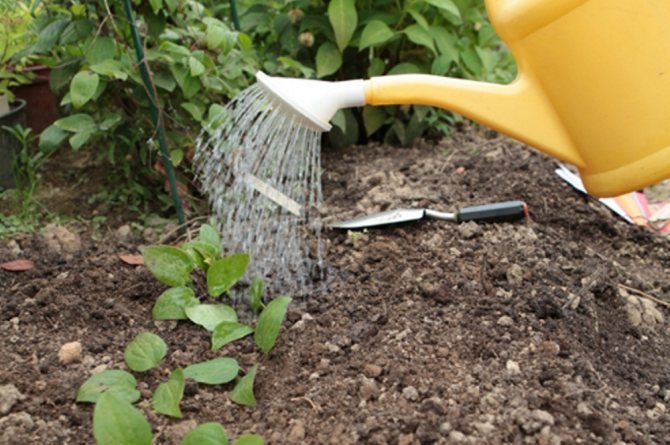

Watering is a prerequisite for the active development of clematis.
- Weed regularly soil around the bush.
- Refresh the mulch layer periodically around Clematis.
- Water the plant abundantly but infrequently.... Pour the water gently, right under the root, so that the above-ground part of the bush gets wet as little as possible. Do not allow excess moisture, but also dry out the topsoil. Young plants especially need moisture.
- Feed Clematis Once a month, alternating mineral fertilizers with organic ones. Apply after watering (on wet soil) to avoid burning the root system.
- Provide a secure footing for a plant with a cell of at least 1 - 1.5 cm. Tie up the growing shoots, forming the desired crown.
- Prune Clematis Correctly (third group of trimming). Perform the first pruning when planting the plant. Pinch the regrown young shoots in the summer to stimulate branching. In the fall, cut off the above-ground part of the shrub, as it dies off during the winter.
- This variety of Clematis does not need shelter.... It is very frost-hardy and even tolerates harsh winters with little snow.
In the video, the florist talks about caring for Clematis Burning. He pays special attention to the creation of support:
Add comment Cancel reply
You must be logged in to post a comment.
Two people were injured.
Who decorates the city.
The 56-year-old resident of Angarsk paid the entire amount of alimony - about 200 thousand rubles.
Irkutskstat calculated which goods our region brings in and which it exports.
The full-time department of Angarsk Technical University enrolled 213 people, of which 198 students will study on a budget.


It can be blue
Well, we have worked, the season is closed. There is nothing to do at the dachas. This means that there is time to share the joy of someone who has grown thicker, taller and richer than a neighbor. I confess that I am a beginner gardener. However, my modest experience may be useful to someone. So let's start with me.
My first purchase for a summer residence, inherited from my parents, was a clematis stalk of the White Cloud variety. The decisive factor was the unpretentiousness of this variety promised by the seller. I am very grateful to the seller, who warned that in the first year the plant may not bloom and you need to be patient. So I didn't wait and didn't get nervous. However, the beginner immediately bloomed with small white fragrant flowers. Every year, the flowering became more and more abundant, which more than redeemed the modest beauty of this shrub vine. The aroma of the flowers was such that bumblebees were constantly buzzing on the site, like in an apiary.
Later, in books on gardening, I read that the biological feature of clematis is such that for the first three years all their strength is spent on building up the root system and forming buds at the base of the bush. Therefore, the ground part of the vine does not at first differ in increased growth and one should not expect a violent flowering from a young plant. My clematis did not require special care: watering, feeding, loosening and mandatory fastening around the support (it is even better to plant a vine near a trellis or netting). For the winter, I cut off the entire ground part almost to the root and covered the base of the bush with it, placing a wooden box on top to protect it from freezing.
For another summer, I bought a stalk of blue clematis (the variety, alas, did not remember). I was looking forward to the first flowering, because re-grading happens both when buying on the market, and when ordering from large firms. All the first summer, the stunted stalk suffered in the shade of the viburnum that obscured it (clematis are very demanding on lighting). Transplanted the next year to another, open, place pleased with the first flowers. There were only five of them. But what kind of flowers were they! White fluffy core framed by long bright blue petals. The large flowers were so unrealistically good that they looked like artificial ones. True, unlike the White Cloud, they almost did not smell. Among the varietal clematis, there are those that combine beauty and aroma.
I fell in love with these plants and am planning to buy a couple more at the gardening fair next spring.
Unfortunately, when cleaning the plot in the fall, my husband, together with the grass, completely destroyed my blue miracle with a lawn mower. It is not a fact that the vine will grow back next year. There are very important subtleties in pruning clematis. All varieties can be roughly divided into two groups: blooming only on young shoots of the current year and blooming on old last year's and young shoots. Often times, shop assistants have no idea what they're selling. In this case, you should be patient and watch a new plant for a couple of years. To do this, leave the old clematis shoots about half a meter long for the winter. And in the spring, look at what maximum height the buds will awaken and where exactly the first flowers will begin to dissolve.
If on your bush flowers are formed on the shoots of the current year, then in the fall the shoots must be shortened to 2-3 buds or cut off completely. If flowers are formed on the shoots of last year, then in the fall we cut off only the leaves, and lay the shoots round on the ground and cover them with the same material as the base of the bush, cover them with fir branches on top. It is not too late to do it now.
The material for publication was prepared by the site administrator.
Things to Remember
- Variety: Clematis pungent
- Reproduction: seeds, cuttings, layering, dividing the bush.
- Landing: sunny, windless area, soil preparation, pit preparation, support construction, root collar deepening, watering, mulching of the trunk circle.
- Care: watering, weeding, changing mulch, loosening the soil, top dressing, pruning in spring, garter, pruning for the winter.
- Diseases and pests: powdery mildew, gray rot, rust, Alternaria, ascochitis.
- Why does not it bloom: improper planting, feeding or pruning, the plant is weakened by diseases, Clematis is too young, the plant is old.
Plant in well-lit areas
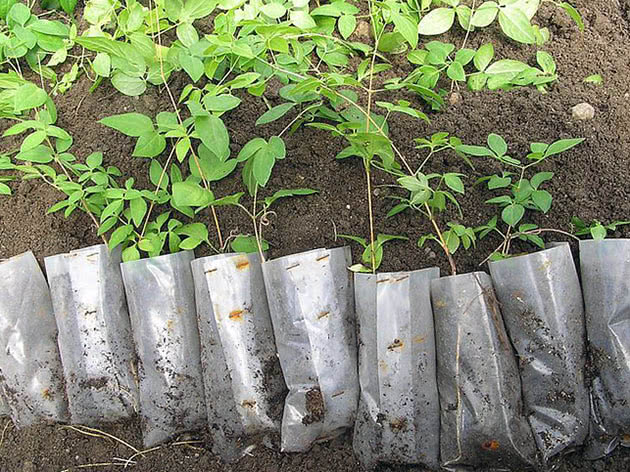

When planting, a distance of at least 1 m is left between the seedlings. Photo:
- Plant Clematis in spring in a cold strip and in early autumn in warm climates.
- Choose a sunny, windless place or light partial shade with low groundwater.
- Prepare the soil before planting: loosen it well and apply mineral fertilizers, peat, humus and compost.
- Dig a hole 60 to 70 cm deep. The roots should be located freely in it.
- Fill in the drainage layer (crushed stone, expanded clay, broken brick, coarse sand).
- Cut the seedling, leaving several buds on the shoots.
- If there are several seedlings, leave a distance between them. not less than 1 m.
- Spread out the roots gently and cover with earth, while the root collar should be deepened by 10 cm.
- Dig a support near the seedling.
- Water abundantly.
- Mulch the trunk circle peat, sawdust or dry leaves.
- Shade the seedling from the bright sun before it takes root.
Application in hedges
Clematis help to effectively decorate various supports - lattices, fences. They are used in the construction of curbs, internal hedges, vertical gardening of walls, decorating external stone fences and frame structures.
Clematis hogweed
used as a curb plant or a dividing fence between separate zones of the garden plot.
Clematis Tangut
used as a curb plant or a low hedge between separate zones of the garden plot.
Whole-leaf clematis
used as a curb plant or in dividing hedges between individual zones of the garden plot.
Clematis grape-leaved, mountainous, short-tailed, paniculate
suitable for vertical landscaping of walls, fences and frame systems.
Clematis Manchu
Recommended for landscaping low areas or in dividing hedges between separate areas of the garden.
Clematis coexist well with bushes of lilac, mock orange, weigela, spirea and forsythia, often these bushes serve as a support for clematis vines. The result is an original hedge between the different areas of the site. The proximity to these plants prolongs the flowering of clematis. Near the base of clematis vines, stunted plants or summer flowers can be planted. They will cover the lower shoots and protect the soil from overheating. For example, calendula will protect clematis from nematodes, as well as the roots of vines from the sun and overheating.
Every novice lover of clematis needs to know this.
The value of clematis is in the structure of the plant. Graceful branches equally easily transform into a flowing floral waterfall, a green fragrant screen or a shady tent. For this reason, and also because of the fantastic beauty of the flowers, these perennials are so loved all over the world. New modern clematis have appeared: planting care and all other processes are simplified and minimized. More than 300 species of varieties of lianas were created by nature and man to delight the eye. There is little to do - to finally start enjoying the process of growing curly splendor. You can find out about the most popular clematis varieties here.

